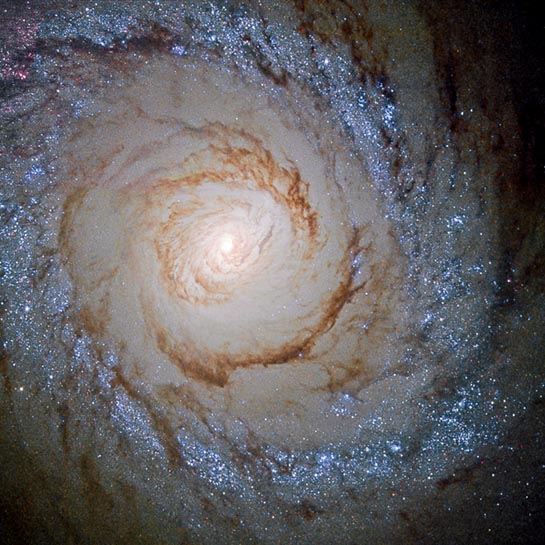
Starburst galaxy
RA 12h 50m 52.52s Dec 41° 7' 19.94"
Canes Venatici
15 million light years
11.2 x 9.1 arcmin
8.99
1.67 x 1.64 arcminutes
North is 75.1° right of vertical
ESA/Hubble & NASA
October 19, 2015
ABOUT THIS IMAGE:
This image shows the galaxy Messier 94, which lies in the small northern constellation of the Hunting Dogs, about 16 million light-years away.
Within the bright ring around Messier 94 new stars are forming at a high rate and many young, bright stars are present within it – thanks to this, this feature is called a starburst ring.
The cause of this peculiarly shaped star-forming region is likely a pressure wave going outwards from the galactic centre, compressing the gas and dust in the outer region. The compression of material means the gas starts to collapse into denser clouds. Inside these dense clouds, gravity pulls the gas and dust together until temperature and pressure are high enough for stars to be born.
From Wikipedia:
Messier 94 (also known as NGC 4736) is a spiral galaxy in the constellation Canes Venatici. It was discovered by Pierre Méchain in 1781 and catalogued by Charles Messier two days later. Although some references describe M94 as a barred spiral galaxy, the "bar" structure appears to be more oval-shaped. The galaxy is also notable in that it has two ring structures.
M94 is classified as having a low ionization nuclear emission region (LINER) nucleus. LINERs in general are characterized by optical spectra that reveal that ionized gas is present but the gas is only weakly ionized (i.e. the atoms are missing relatively few electrons).
M94 contains both an inner ring with a diameter of 70" and an outer ring with a diameter of 600". These rings appear to form at resonance locations within the disk of the galaxy. The inner ring is the site of strong star formation activity and is sometimes referred to as a starburst ring. This star formation is fueled by gas that is dynamically driven into the ring by the inner oval-shaped bar-like structure.
A 2009 study conducted by an international team of astrophysicists revealed that the outer ring of M94 is not a closed stellar ring, as historically attributed in the literature, but a complex structure of spiral arms when viewed in mid-IR and UV. The study found that the outer disk of this galaxy is active. It contains approximately 23% of the galaxy's total stellar mass and contributes about 10% of the galaxy's new stars. In fact, the star formation rate of the outer disk is approximately two times greater than the inner disk because it is more efficient per unit of stellar mass.
There
are several possible external events that could have led to the origin
of M94's outer disk including the accretion of a satellite galaxy or the
gravitational interaction with a nearby star system. However, further
research found problems with each of these scenarios. Therefore, the report
concludes that the inner disk of M94 (NGC4736) is an oval distortion which
led to the creation of this galaxy's peripheral disk.